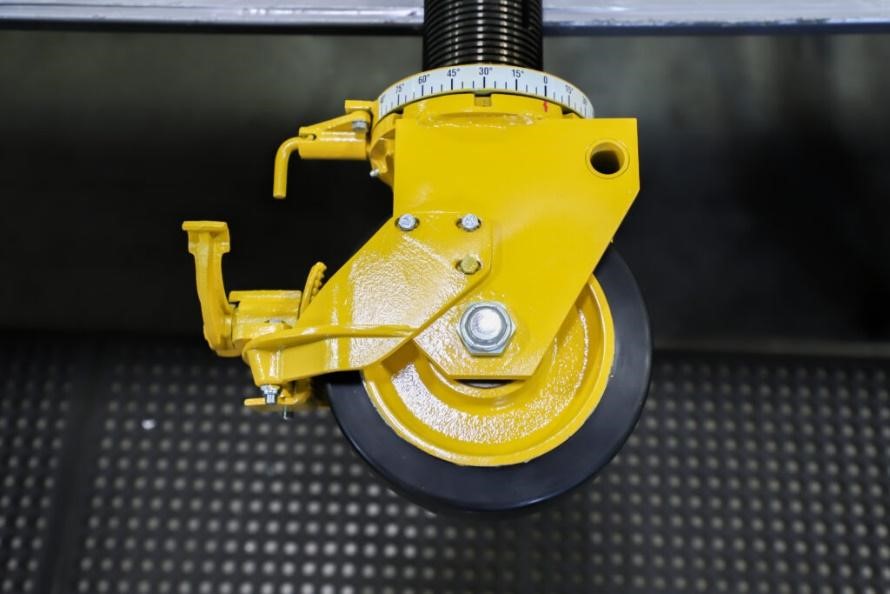Some components often remain overshadowed despite their crucial roles in the vast realm of military technology. Among these, caster wheels stand out, particularly when integrated into ground support equipment for military use.
What Will You Learn?
This article spotlights two specific variants: jacking casters and aluminum casters, each with unique advantages and applications. As we delve deeper, readers will gain insights into how these casters fortify military operations, ensuring efficiency and safety. By the end, the underrated significance of these casters in enhancing military mobility will be unmistakably clear.
The Evolution of Industrial Caster Wheels in Military Tech
Historically, industrial caster wheels held a primary utility role, simplifying movement and transportation. However, the demand for more specialized solutions grew exponentially as military technology advanced.
Aluminum casters, recognized for their durability and lightweight nature, began playing a pivotal role in ground support equipment for military applications. This transition from general use to specific military roles exemplifies the dynamic nature of technological adaptation. Today, these specialized industrial casters aren’t mere support components; they are integral to the efficiency and efficacy of modern military operations.
Ground Support Equipment for Military: The Backbone
Ground support equipment serves as an essential pillar in military operations. This equipment stands resilient from the harshness of rain and snow to the extremities of temperature.
Central to its efficiency are the industrial caster wheels, crucial for securely maneuvering and directing hefty objects. These components have revolutionized the way large objects are maneuvered. Ensuring smooth, stable rides across diverse surfaces minimizes the risks associated with rough terrains and environmental challenges.
Outdoor heavy-duty industrial caster wheels, renowned in the United States for their resilience and cost-effectiveness, find extensive usage across industries, including every military branch. These wheels, known for their durability and low maintenance, underscore the importance of quality in safeguarding valuable military assets.
Through ensuring operational efficiency and safety, ground support equipment with large industrial caster wheels has solidified its place as an indispensable tool in the vast array of military applications.
Aluminum Casters: The Lightweight Champions
In military operations, efficiency and adaptability are paramount. Aluminum casters have swiftly risen as the favored choice for many industries, including the demanding contexts of the Armed Forces, mainly due to their inherent advantages.
Distinctive Advantages of Aluminum Casters:
- Weight Efficiency: The lightweight nature of aluminum casters ensures swift maneuverability without compromising strength.
- Durability: Recognized globally, the lasting durability of aluminum casters, coupled with their low maintenance requirements, sets them apart.
- Resistance: Aluminum’s natural resistance to corrosion, especially from moisture, abrasives, or other foreign substances, offers longevity in diverse environments.
Comparative Analysis:
While other materials might present certain advantages, aluminum’s unique properties make it unparalleled. Its high tensile strength, combined with uniform sectional properties, positions it as a top choice.
Engineers and metallurgists, in their quest for the best, have identified aluminum’s adaptability to permanent mold casting as a significant advantage. This decision is further solidified when applications demand features like spark-proofing, high corrosion resistance, or minimized weight. Aluminum casters, in these scenarios, emerge as the uncontested champions, marking a new era in modern materials handling within the military sphere.
Jacking Casters: Elevating Military Efficiency
Jacking casters, integral components within the caster industry, are sophisticated tools designed for precision. Whether crafted from resilient steel or lightweight aluminum, these casters offer unparalleled leveling capabilities, especially on uneven terrains.
In real-world military applications, such industrial tools prove invaluable. For instance, during deployments in uneven terrains, these casters swiftly adjust military platforms, ensuring that equipment remains stable and functional, regardless of the ground inconsistencies.
Benefits that Transform Operations:
- Rapid Adjustments: Heavy-duty jacking casters enable quick vertical adjustments, optimizing the functionality of working platforms and machinery.
- Precise Leveling: On challenging surfaces, the accurate leveling of these casters shines, ensuring stability in diverse military operations.
- Versatility in Material: Whether opting for steel for its strength or aluminum for its weight advantage, the caster industry provides options to suit varied needs.
Integrating Hydraulic Brake Actuators with Caster Wheels:
Hydraulic brake actuators, particularly the “Surge System,” represent a paradigm shift in towing safety and efficiency. Essentially, these devices actuate hydraulic brakes in towed equipment in response to any decelerating force from the towing vehicle, ensuring prompt brake responses.
Actuator Advantages in Military Operations:
- Responsive Braking: The AEROL surge brake actuator ensures brakes respond effectively to any force, whether due to deceleration, lurching, or descending a slope.
- Safety Assured: The system is designed to absorb sudden shocks and prevent sporadic brake applications on rough terrains. Its automatic hydraulic bypass also negates brakes during reverse motions, ensuring smooth operations.
- Fail-Safe Features: In case of pintle hook or safety chain failures, a mechanical linkage activates, bringing the trailer to a halt and amplifying safety measures.
When integrated with industrial caster wheels, these actuators boost mobility and safety in ground support equipment for military operations.
Given the surge system’s capacity to handle trailers weighing up to 22,000 pounds, it becomes evident that each integration must be custom-tailored for optimal performance. With such advancements, military tech operations gain heightened precision and security.
Future Prospects: Where is the Military Tech headed with Caster Innovations?
The landscape of military tech is rapidly evolving, and caster innovations play a pivotal role in this trajectory.
Trends on the Horizon:
- With the integration of sensors and AI, future casters might offer real-time diagnostics, ensuring optimal performance and timely maintenance.
- Beyond the proven efficiency of aluminum casters, research might soon introduce materials offering even greater strength-to-weight ratios, amplifying durability, and load-bearing capacities.
- Jacking casters and hydraulic brake actuators could soon work with automation systems, enabling equipment to self-adjust to terrains or deploy brakes autonomously.
Given these potential advancements, military applications will likely demand industrial casters that support heavy loads and integrate seamlessly with advanced tech platforms.
Aerol: Pioneering Superior Casters for Military Operations
At the forefront of innovation stands Aerol, a representation of dedication to manufacturing top-tier casters tailored for demanding military applications. Navigating the difficulties of aerospace and military standards, Aerol’s expertise in precision design ensures that the products are nearly invulnerable.
The result? Aluminum and shock-absorbing casters, all meticulously engineered for the paramount safety and transport of heavy-duty military payloads. Understanding the unique industry needs, we also offer custom solutions.









